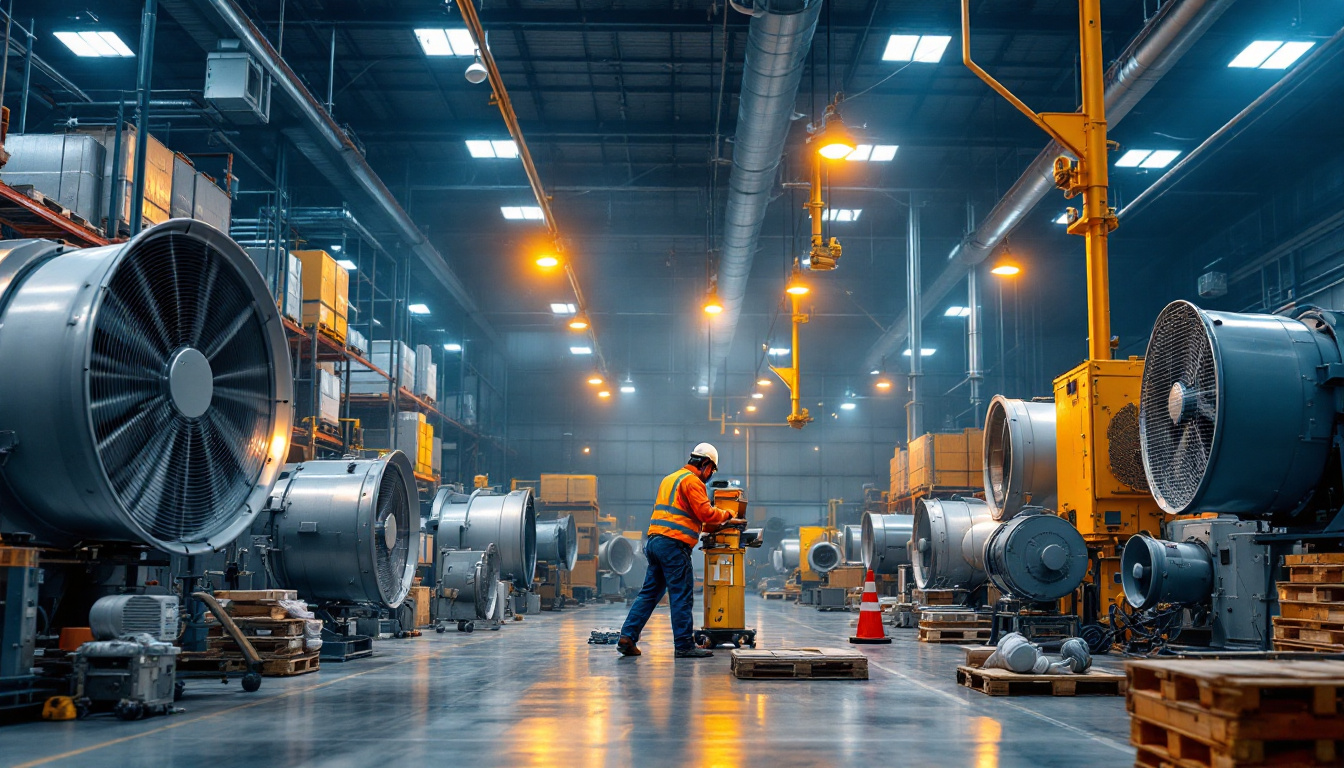
In the world of warehouse lighting, the integration of fans is often overlooked, yet it plays a crucial role in maintaining optimal conditions for both employees and equipment. Lighting contractors, while experts in their field, can sometimes make common mistakes when it comes to the installation and selection of warehouse fans. Understanding these pitfalls can lead to improved efficiency, better air circulation, and enhanced overall performance in warehouse environments.
Before delving into the common mistakes, it is essential to recognize why warehouse fans are vital. They not only help in regulating temperature but also improve air quality, which can significantly enhance worker productivity. Proper air circulation can prevent overheating of equipment and reduce humidity levels, thereby safeguarding inventory and machinery. Additionally, the presence of well-placed fans can lead to energy savings, as they allow for a more efficient use of heating and cooling systems, ultimately reducing operational costs.
Stagnant air can lead to a buildup of dust, pollutants, and odors, which can adversely affect both the health of employees and the integrity of stored goods. Warehouse fans help to circulate fresh air, diluting harmful particles and creating a more pleasant working environment. This is particularly important in warehouses that store sensitive materials or where employees are engaged in physical labor. Moreover, improved air quality can reduce the risk of respiratory issues among workers, fostering a healthier workforce and potentially lowering absenteeism due to illness. Regular maintenance of these fans is also crucial, as dirty filters can hinder their effectiveness and lead to the circulation of contaminants.
In warehouses, especially those with large open spaces, temperature control can be a challenge. Fans assist in distributing warm air that rises to the ceiling, ensuring that the temperature remains consistent throughout the space. This is crucial not only for comfort but also for compliance with safety regulations that dictate acceptable working conditions. Furthermore, the strategic placement of fans can create a wind-chill effect, making it feel cooler during the hot months without the need for excessive air conditioning. This not only enhances employee comfort but also contributes to energy efficiency, as it allows for a more balanced approach to temperature management. In colder months, reversing the direction of ceiling fans can help push warm air down from the ceiling, further optimizing heating efforts and reducing energy consumption.
One of the first steps in ensuring effective airflow in a warehouse is selecting the appropriate fans. However, lighting contractors often make several common mistakes in this area.
One of the most frequent errors is choosing fans that are too small for the space. A fan’s size directly impacts its ability to move air effectively. When fans are undersized, they may not provide adequate airflow, leading to hot spots and poor air quality. It is crucial to calculate the required fan size based on the warehouse’s dimensions, ceiling height, and the specific airflow needs of the environment. Additionally, factors such as the layout of the warehouse, including any obstructions like shelving or machinery, can further complicate airflow dynamics. For instance, a large warehouse with high ceilings may require multiple fans strategically placed to ensure even distribution of air, rather than relying on a single, smaller fan that could leave significant areas uncooled or poorly ventilated.
Another common oversight is failing to consider the direction of airflow. Fans can either push air down or pull air up, and the choice between these options can significantly affect the overall air circulation in the space. For instance, ceiling fans that push air down can create a cooling effect, while those that pull air up can help in exhausting hot air. Understanding the intended purpose of the fans is essential for optimal performance. Moreover, the seasonal changes in temperature should also influence the airflow direction; during warmer months, downward airflow can enhance comfort, while in colder months, reversing the direction to pull air upwards can help redistribute warm air that accumulates near the ceiling. This adaptability not only improves energy efficiency but also contributes to a more stable and comfortable environment for both workers and stored goods.
The placement of fans is equally important as their selection. Incorrect positioning can lead to inefficient airflow and wasted energy. Lighting contractors must carefully consider the layout of the warehouse and the specific areas that require enhanced ventilation. For instance, placing fans too close to walls or obstructions can create dead zones where air circulation is minimal, resulting in hot spots that can affect both employee comfort and product integrity. Additionally, the height at which fans are mounted can significantly influence their effectiveness; fans positioned too low may disrupt workflow, while those mounted too high may not provide adequate cooling to the work areas below.
In many cases, contractors may overlook the workflow patterns within the warehouse. Areas with high employee traffic or where machinery operates should receive priority when positioning fans. By analyzing these patterns, contractors can ensure that airflow is directed where it is most needed, promoting a more comfortable working environment. Furthermore, understanding peak operational hours and the specific tasks being performed can help in adjusting fan settings or even implementing variable speed fans that adapt to changing conditions throughout the day. This proactive approach not only enhances comfort but can also improve overall productivity, as employees are less likely to be distracted by heat or stagnant air.
Creating distinct airflow zones can help in managing temperature and air quality more effectively. By strategically placing fans in different sections of the warehouse, contractors can ensure that each zone receives adequate ventilation. This approach can be particularly beneficial in larger warehouses where airflow might be uneven. For example, areas designated for storage of temperature-sensitive materials may require more focused airflow to prevent spoilage, while loading docks might benefit from increased ventilation to dissipate exhaust fumes from vehicles. Additionally, incorporating sensors to monitor air quality and temperature in each zone can provide valuable data, allowing for real-time adjustments to fan operation and ensuring optimal conditions are maintained throughout the facility.
Energy consumption is a significant concern for warehouse operations, and fans can contribute to high energy costs if not chosen wisely. Lighting contractors must prioritize energy-efficient options to help reduce operational expenses.
One common mistake is opting for fans that do not have an Energy Star rating. These fans may be cheaper initially, but they often consume more electricity in the long run. Energy-efficient fans not only save money on utility bills but can also qualify for rebates and incentives, making them a more cost-effective choice overall.
Variable speed fans allow for greater control over airflow and can adapt to changing conditions within the warehouse. By neglecting to consider these options, contractors may miss out on the opportunity to optimize energy use. Implementing fans with variable speed settings can lead to significant energy savings and enhance overall system performance.
In many warehouses, lighting and ventilation systems are treated as separate entities. However, integrating these systems can lead to improved efficiency and comfort. Lighting contractors often make the mistake of not considering how fans and lighting interact.
Lighting systems, especially those using high-intensity discharge (HID) bulbs, can generate significant heat. This heat can affect the overall temperature of the warehouse, making it essential to coordinate fan placement and operation with lighting systems. By understanding how lighting impacts temperature, contractors can better design a system that maintains optimal conditions.
Smart controls can enhance the integration of lighting and fan systems, allowing for synchronized operation based on occupancy and environmental conditions. Failing to implement these controls can result in inefficient energy use and discomfort for employees. By utilizing smart technology, contractors can create a more responsive and efficient system.
Even the best-installed fans will not perform effectively if they are not properly maintained. Lighting contractors sometimes overlook the importance of maintenance when selecting and installing fans.
Some fan models may be difficult to access for cleaning and maintenance, which can lead to reduced efficiency over time. It is essential to select fans that are easy to maintain and clean, ensuring that they continue to operate at peak performance. Contractors should consider the long-term maintenance requirements when making their selections.
Contractors have a responsibility to educate their clients about the importance of regular maintenance for warehouse fans. This includes providing guidance on cleaning schedules and the signs of wear that may indicate a need for repairs. By fostering a proactive maintenance culture, contractors can help clients maximize the lifespan and efficiency of their fans.
In conclusion, the integration of warehouse fans into lighting systems is a critical aspect of creating a comfortable and efficient working environment. By avoiding common mistakes related to fan selection, placement, energy efficiency, integration, and maintenance, lighting contractors can enhance their projects and provide greater value to their clients.
As the demand for optimized warehouse operations continues to grow, understanding the nuances of fan installation will become increasingly important. By staying informed about best practices and emerging technologies, lighting contractors can ensure they remain at the forefront of the industry, delivering solutions that meet the evolving needs of warehouse environments.
Ultimately, a well-designed fan system can lead to improved air quality, better temperature regulation, and enhanced employee satisfaction, making it a worthwhile investment for any warehouse operation. By prioritizing these considerations, lighting contractors can help create spaces that are not only functional but also conducive to productivity and well-being.
Ready to avoid common mistakes and set up your warehouse lighting and fan systems with confidence? LumenWholesale is here to support you every step of the way. Our extensive selection of spec-grade lighting products, including high-efficiency warehouse fans, ensures that you have access to the best solutions on the market. With unbeatable wholesale prices and the convenience of free shipping on bulk orders, you can trust that you’re getting the highest quality without the extra costs. Elevate your warehouse projects with the perfect blend of quality, affordability, and convenience. Discover the value we offer by visiting Wholesale Lighting at the Best Value today.

Discover essential tips and insights for lighting contractors looking to integrate automated lighting solutions.

Discover essential tips and common mistakes to avoid when installing 4-foot LED strips with insights from experienced lighting contractors.

Discover the truth about LED lights and ballasts in this insightful guide for smart lighting contractors.

Discover how industrial hanging lamps can revolutionize your lighting projects by enhancing efficiency and aesthetics.